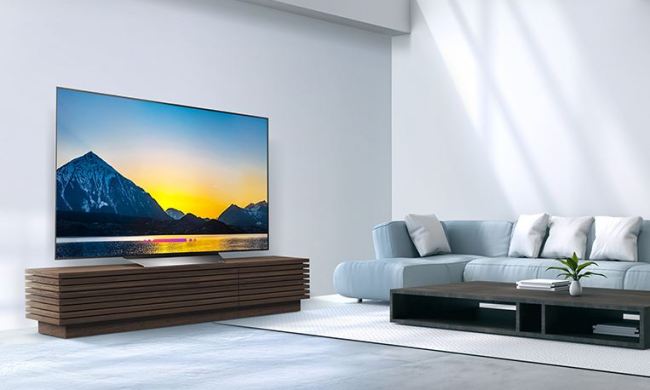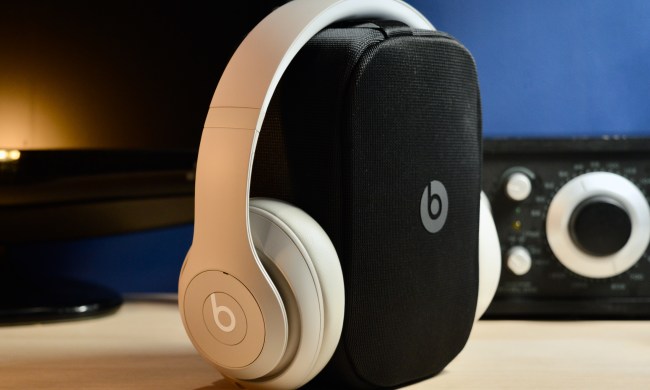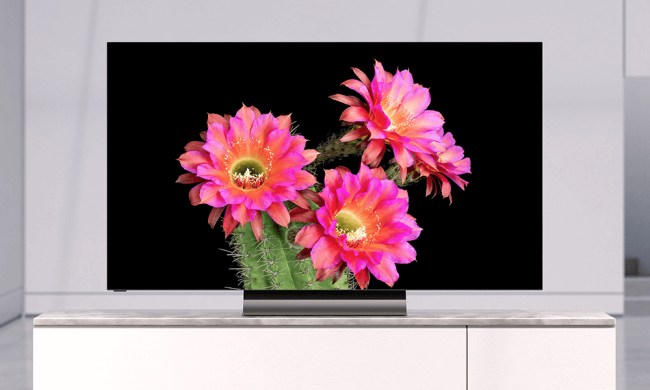
- Vivid detail and definition
- Warm and rich low end
- Subtle, yet accurate treble
- Huge sound stage
- Pure, distortion-free sound
- Comfortable, stylish design
- Flimsy headphone cable
- Elite price tag
Oppo Digital is best known to most as a purveyor of high-end Blu-ray players – the kind loaded with premium components that are revered by audiophiles and videophiles alike. So, when the company recently announced plans to get into the premium headphone game, people took notice. And when Oppo revealed its first take would be a line of planar magnetic headphones – perhaps the most coveted headphone driver tech out there — just about everyone in the industry got a case of whiplash.
The result of Oppo’s efforts, the flagship PM-1 ($1,100), meld a gorgeous blend of modern styling, ergonomic design, and meticulously pored-over engineering for a truly impressive offering to the field of high-end cans. We spent some exhilarating hours with the PM-1 paired with an array of sources to see how the company’s freshly-minted cans stack up.
Oppo PM-1 hands-on video
Out of the box
While the PM-1 do come in a box, with book-bound siding of grey tweed, the package inside could hardly be categorized so callously: It’s more of a chest or cabinet, steeped in richly lacquered wood that hints at a treasure inside. Opening the case revealed the PM-1 in all their neo-modern glory, with polished aluminum ribbons encircling oversized ear cups in black, and a supple leather pad stretched across their thick headband.
The ‘phones feel fairly heavy in the hand, though much lighter than the last planar magnetic headphones we tested, Audeze’s seminal LCD-3. The plastic-encased ear cups felt solid, and glided fluently along tracks of gleaming chrome. While we think most users will store these luxurious cans in their beautiful cabinet rather than inside a travel bag, their sturdy construction leaves no doubt they are resilient enough to hit the road.
Accessories inside the cabinet included two sets of ear pads, one cloaked in fine leather matching the headband, and the other in velvety velour. Also included was the sole source of a minor disappointment: a thin, short (3-foot) 3.5mm cable with ¼-inch adapter, which allows the PM-1 to connect to a mobile device. We’d like to see a longer robust cable here. A 4-pin balanced headphone cable is also available at additional cost. Finally, Oppo supplies a denim carrying case with a velour interior just big enough to fit the ‘phones.
Features and design
As elegant and concise as the PM-1 are, it’s what Oppo put inside those elongated ear cups that is most intriguing. The fancy phrase we keep bandying about, planar magnetic, refers to a driver design that’s fundamentally different from most speakers you’ll encounter.
Instead of a traditional cone and coil design, planar drivers employ a thin membrane, sort of like a drum head, which is layered with a conductor circuit, and placed within a magnetic field. It moves much more subtly than a dynamic driver, which allows for stunning accuracy and precision. Oppo’s version uses a 7-layer membrane with a “spiraling pattern of flat conductors etched on both sides,” along with a host of other premium, meticulously designed components. In short, there’s a lot of engineering brawn and brains built into these cans.
Oppo claims its take on the planar magnetic design allows for higher sensitivity. Add to that an almost ridiculous claimed frequency response stretching from 10Hz (nearly as low as you can go) to 50kHz (2.5 times higher than the limits of human hearing). The headphones also have a 32 Ohm impedance rating, allowing you to easily power them with a mobile device.
The PM-1 employ an open-backed design, which means there’s nothing standing between the drivers and the ears of the people around you. More on that in a moment.
Comfort
As mentioned, the PM-1 are a tad heavy, especially with the thick four-pin cable attached, but the pad on top is enough to dampen pressure for extremely long listening sessions. The leather pads were comfortable enough against our ears, but the velour pads brought a touch of sheer luxury, begging us to keep the PM-1 on our noggin. The velour pads also alter the sound a bit, bringing a hint of more subtle warmth to the response. The earpieces swivel for an ergonomic fit, and also rotate to fold flat, making a quick music break effortless.
Setup
Before we begin, a few words regarding open-back headphones: While such an approach is conducive to a very open, spacious sound, they provide virtually no noise isolation. Everyone around you can hear your music, and you can hear everyone around you. For example, during one of our late night listening sessions, we heard the ruffling of a custodian emptying the garbage from clear across the office.

It should also be understood that investment in a quality source, such as the Antelope Zodiac DAC, or Oppo’s HA-1 (both of which we used for testing) is a near necessity. While the PM-1 certainly sounded good through our iPhone 5, moving to a quality amp unleashed their full potential, exposing a wide delta in performance. With a proper headphone amp, we got wider extension of definition and spacing, more rich and buttery flavors in the midrange and bass, and crystalline, yet sublimely subtle treble reproduction.
Performance
As you’d expect, the PM-1 offered exquisite detail, exposing the most intricate of musical moments. We not only heard the deepest textures and overtones in a tenor sax solo and acoustic guitar track, but also the subtle movement of each breath as it bubbled through the woody reed, and the varied accent of each strum of a pick, hovering just above the production. Yet, when we alternated between the PM-1 and the much more affordable Shure SRH1450, we found the differences in detail to be subtle.
The most distinctive differences between the two were exposed in the utter depth of the instrumental textures and the overall delivery of the sound, which took a longer sonic journey to fully realize. It was like a vision quest for our ears – if we’d had some peyote, it probably would have jumped out at us like a purple tiger from a broiling lake of fire. But, when it comes to high-end audio, sometimes it takes a little work to peel back those subtle layers and, we assure you, the PM-1 will reward your efforts.
The PM-1 delved much deeper into the bass then we expected from planar cans.
The ‘phones seemed to strip away all extraneous information absolutely, as if taking the digital and electrical chatter totally out of the music, even for low-res files. They exposed instruments in a subtle, pure form, making the SRH1450 seem almost aggressive at times by comparison. The effect removed some of the excitement from snare snaps and guitar grit (especially with the Antelope Zodiac) but in return, we were able to better explore each timbre and color at will, peacefully wandering through the dimensions of sound, and raising the volume level at our leisure with zero audible distortion.
We thoroughly enjoyed our time with the requisite hi-res jazz and classical selections, but, as expected, the most dazzling moments came from complex productions like Radiohead’s Amnesiac. We hadn’t auditioned the album in years, recalling it as one of the band’s more subtle offerings. Not so much. In each track, the PM-1 uncovered a veritable carnival of textures and sounds.
One particularly stunning listen came from “Pyramid Song,” which began with orchestral crowd noise that sounded miles away, and rose to the construction of a ghostly invasion of fluid synth layers, diamond-cut percussion textures, and “Knights in White Satin” horns, all of which rendered us utterly transfixed.
That said, richly produced acoustic numbers like Ray LaMontagne’s “I Still Care for You” were nearly as impressive through a quality source. The reverb trail on Ray’s vocal in the track seemed to wind through the PM-1’s wide halls for hours before dissipating. The heavy toms thumping in precise spacing on the left side were rich as Burgundy, yet utterly lyrical. And the acoustic guitar offered a lifelike exposure of granular string clicks. Two tracks away, “Gossip in the Grain” was all but a symphonic masterpiece as the full production of flute, guitar, and voice reached its zenith.
The PM-1 also delved much deeper into the bass then we expected from planar cans. While they never reached the supernatural dimensionality, or accuracy of the Audeze LCD-3 (which cost a pretty penny more), they sunk lower and more smoothly into the low end, scoring an impressive coup there.
Conclusion
Oppo’s PM-1 succeed on all levels – not bad for the first shot out of the gate. Perhaps just as exciting, the company’s forthcoming PM-2 is priced much more reasonably ($700), and promises comparable sound quality. For those who do a lot of listening on mobile devices, it should be noted that the PM-1’s superior performance is less apparent when listening on a phone than you may expect, considering how much they cost. But connected to a quality component, the stylish PM-1 offer a staggering combination of warmth, dimension, clarity, and definition that will utterly satisfy your audiophile fix.
Highs
- Vivid detail and definition
- Warm and rich low end
- Subtle, yet accurate treble
- Huge sound stage
- Pure, distortion-free sound
- Comfortable, stylish design
Lows
- Flimsy headphone cable
- Elite price tag









